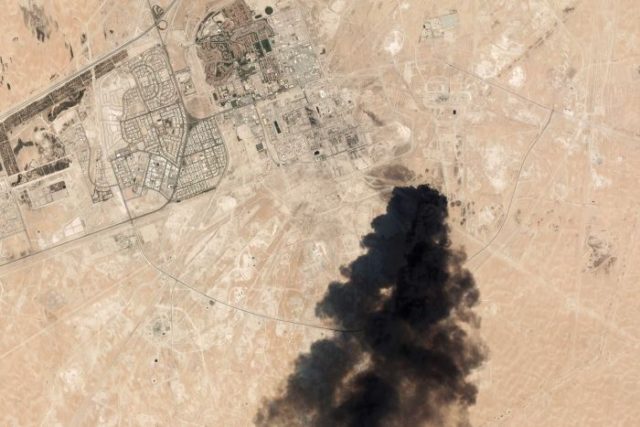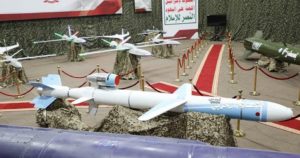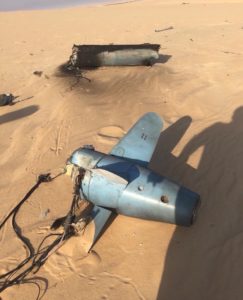
It is growing more certain that the attacks on the Khurais oil field and the Abqaiq oil processing center in Saudi Arabia were launched from southern Iraq and not from Yemen by the Houthis. This was made clear by Secretary of State Mike Pompeo who said “There is no evidence the attacks came from Yemen.” While Pompeo put the blame squarely on Iran, he did not say where the attacks originated. Meanwhile the Saudi Arabian Air Force launched retaliatory attacks on Houthis military sites in Yemen.
It is quite true that Yahia Sarie, the military spokesman for the Houthi forces in Yemen, appearing on al-Masirah satellite news channel, in a short TV address, claimed that the Houthis had launched ten suicide drones and had help in targeting Saudi oil facilities from “intelligence” from sources inside Saudi Arabia.
But sources in Iraq and Washington say that the attacks were launched from Iraq, most likely from pro-Iranian militias operating in the open and guided by Iran’s al-Quds (Revolutionary Guards) forces, led by Major General Qasem Soleimani. It was this same force that recently attempted to launch a swarming drone attack on Israel.
It is possible that Soleimani feared some deal emerging between the Iranian government and the United States, and launched this attack as a preemptive strike. But offsetting this thesis is the fact that the preparation for this strike took some time and required the movement of a lot of equipment from Iran to Iraq, and careful intelligence about the Saudi targets. This weighs against the preemption theory.
But whichever way, there isn’t much doubt in the minds of Iraqi observers.
The leading Iraqi analyst based in the United States is Entifadh Qanbar, President and Founder of the Future Foundation. He previously served as Iraq’s Deputy Military Attaché and as the spokesman for and adviser to Iraq’s Deputy Prime Minister. He closely follows developments in his home country and has many associates feeding him information that has more than once proved to be accurate. His information about the attack coming from iraq is backed up by prior history and by Pompeo’s clear declaration.
As Qanbar knows, this attack would not be the first time that Iran has used Iraq to hit Saudi oil facilities. At least one major previous attack was launched by Iraqi militias and the Iranians from Iraqi territory. Last June the Wall Street Journal carried an important report, based on conclusions reached by US officials, that a May 14th drone attack on Saudi Arabia’s oil industry originated in southern Iraq. According to the Journal, when challenged by the United States, Iraqi officials requested more information and claimed there was no conclusive evidence the attacks originated on their territory.
There are a number of Iranian-guided Sh’ia militias in Iraq that have received drones from Iran. Former senior Iraqi officials in Washington who are opponents of the current Iraqi government they view as compromised by Iran, believes the likely culprit is Harakat Hezbollah al-Nujaba (Movement of the Party of God’s Nobles). Hezbollah al-Nujaba had been heavily involved in the fighting in Syria and has received from Iran and operated a drone called the Yasir UAV (drone), based on the US Boeing-Insitu ScanEagle. Iran apparently captured a few ScanEagle drones and cloned them, and also changed them from surveillance models to suicide drones. This drone has an endurance (depending on model) of between 8 and 20 hours, making it more than capable of flying from southern Iraq to the Saudi oil facilities. ““The (suicide) drone can be used for hitting the aerial and ground targets and can carry out an attack when it identifies a suspicious target,” Iranian Army Ground Force Commander Brigadier General Ahmad Reza Pourdastan” said in 2015.
But Iraqi observers say that the attack on Abqaiq involved three drones and three cruise missiles. The cruise missile is believed to be the Quds-1. A version of the Quds-1, using a small jet engine (model PBS TJ100 ) manufactured in the Czech Republic, is produced in Iran for the Houthis. Nothing specific is known of the range of the Quds-1 but experts say it is a version of Iran’s Soumar cruise missile. But the Quds-1, with its 43 pound Czech turbine engine, probably carries a smaller payload than the Soumar, and the Soumar could have either a Russian or Chinese engine. (The Soumar is said to resemble the Russian Kh55SM cruise missile.) Iran likely replaced the more capable engines of their Quds-1 with a lesser powered system for the Houthis, primarily so as not to implicate the Russian or Chinese suppliers, since the Iranian version has very long range (2,000 km or more) and large warhead.
 (The Quds-1 with the Czech-supplied engine on top. The rear portion is a ricket assist for launch and is discarded. The warhead is in the front section.)
(The Quds-1 with the Czech-supplied engine on top. The rear portion is a ricket assist for launch and is discarded. The warhead is in the front section.)
The Houthis previously fired a Quds-1(reported on July, 29th) at the Abha International Airport in Asir, which is located close to Yemen near the Red Sea. According to the Houthi military spokesman, “[the] Quds 1 missile targeted the military operations center and warplanes’ locations at the airport. A number of civilians were injured in the attack, including one carrying an Indian passport. There is no information about damage to military aircraft or military compounds at the airport.
If the Iraqi reports are accurate, then other missiles or drones or both were launched at the Khurais oil field facilities. Houthi spokesman has used the term “10 drones” but did not mention cruise missiles.
The Houthis have a variety of Iran-supplied drones which are re-badged by the Houthis. If the attacks on the oil facilities did not use the weaponized Yasir UAV, which is rather small, it is probable that the drones used were Houthi models of the Iranian Ababil 2/T which the Houthis have named the Qasef-2K. An earlier version, Qasef-1 has been exploited by Western technicians and experts, including experts from the United Nations. The warhead is a molded high explosive fragmentation type stuffed with ball bearings to cause maximum damage. These drones, classified as loitering munitions, are powered either by German (3W110i B2 engine) or Chinese (DLE-111 two-cylinder petrol model manufactured by the Chinese company Mile HaoXiang Technology Co. Ltd.) two-cylinder engines and push propeller and can fly at least six hours. In the UN Security Council Report, the range for the Qasef drone which it calls UAV-X is between 1,200 and 1,500 km (745 to 932 miles).
Why Deception?
It would have been strongly in Iran’s interest to make the attacks on the Saudi oil facilities look like they were launched by the Houthis. The Houthis were exceptionally happy to take responsibility for an attack that may have destroyed half of Saudi Arabia’s daily oil production. Most reports say that the destruction of the Saudi facilities have cut supplies by 5 million barrels per day. Saudi oil output has been down in 2019 delivering less than 10 million barrels per day. The loss of Abgqaiq, which removes impurities from Saudi oil before being shipped from the Kingdom may mean the loss in output could even be greater. Oil prices are already surging upwards.
The previous attack launched from Iraqi territory was designed to avoid Saudi and US air defenses, particularly the Patriot (MIM-104) surface to air missile system. Previous Houthi drone attacks had been aimed to neutralize Patriot by destroying Patriot surveillance and targeting radars. In this latest attack, however, it seems the main idea was to avoid the Patriot system altogether by attacking from behind (from the north) where the Patriot is not looking. To make the problem even more difficult for the Saudis defending theiroil facilities, the attack featured a swarming-type scenario (multiple UAV’s) mixed with cruise missiles, meaning the attack would come from different operating altitudes to confuse Saudi and US radars.
Another feature of the scheme was to avoid jammers. Increasingly, jammers are being used as a counter drone strategy. For jammers to work the target has to be identified, usually by radar and the jammer activated on the frequencies used by the drones or cruise missiles. The drones used in the attack were far from their control center locations and were probably flying autonomously without a data link, pre-programmed with attack coordinates. Thus the only jammer target would be to try and disable the drone’s GPS or to send false coordinates to the GPS. It is not known if any jammers were positioned to carry out this tactic. In any case, jammers probably are limited and may not be successful in the case of swarming attack drones and missiles.
Other tactics may also have been used, such as flying at extremely low altitude as the drones approached their targets in order to avoid radar detection.
There is no evidence that the Saudi Patriot system was activated, nor is there any information that jamming was used, suggesting that the attack that hit the facilities between 3 and 4 AM local time was not picked up by radar or any other sensor.
A photo of a crashed and exploded Quds-1 cruise missile said to have attacked the Saudi facilities is circulating on Twitter. The photo is almost certainly a Quds-1 (judging from the fins configuration). The origin of the photo is unsourced.
 (Note the Tail fins that are the same as on the Quds 1 model shown above.)
(Note the Tail fins that are the same as on the Quds 1 model shown above.)
Iran has denied any and all responsibility for the attack on Saudi Arabia’s oil facilities, no doubt to try and avoid a retaliatory strike that would knock out critical Iranian oil facilities. Any successful attack on Iran’s oil terminals and other facilities would decisively collapse the current regime who would run out of hard currency and suffer immediate and fatal domestic currency inflation or collapse.
But nonetheless, as Secretary of State Pompeo said: “Tehran is behind nearly 100 attacks on Saudi Arabia while Rouhani and Zarif pretend to engage in diplomacy.
Amid all the calls for de-escalation, Iran has now launched an unprecedented attack on the world’s energy supply.”





